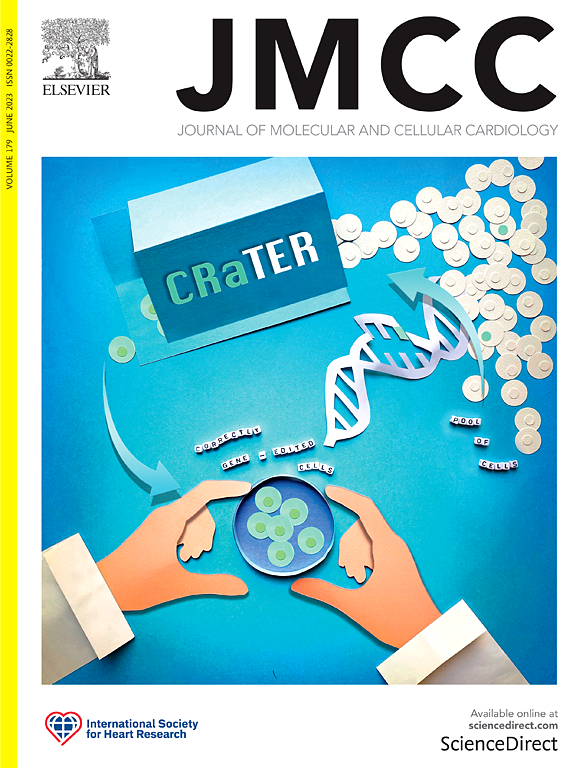Autoinhibition of cMyBP-C by its middle domains
IF 4.7
2区 医学
Q1 CARDIAC & CARDIOVASCULAR SYSTEMS
引用次数: 0
Abstract
Cardiac myosin binding protein-C (cMyBP-C) is a sarcomere regulatory protein consisting of 11 well-folded immunoglobulin-like (Ig-like) and fibronectin type-III domains with the individual domains numbered C0-C10. Despite progress in understanding the functions of the N′ and C′-terminal ends of the protein, our understanding of the functional effects of the middle domains (C3-C4-C5-C6-C7) is still limited. Here we aimed to determine the functional significance of the middle domains by replacing endogenous cMyBP-C with recombinant proteins with and without the middle domains using our “cut and paste” SpyC3 mouse model. Specifically, we deleted domains C3-C7 or substituted these domains with unrelated Ig-like domains from titin to behave as inert “spacer” domains. Replacement with the spacer constructs resulted in a significant increase in myofilament calcium sensitivity, an almost instantaneous redevelopment of tension after a slack re-stretch protocol, and altered stretch activation responses, suggesting that the middle domains are functionally relevant and normally exert inhibitory effects on force development. We also investigated the significance of a potentially flexible linker between domains C4 and C5 and a unique 28 amino acid loop insertion in C5. Whereas deletion of the C5 loop had no effect on force, deletion of the linker between C4 and C5 had comparable effects to deletion of domains C3-C7. Taken together, these data indicate that the middle domains play an important role in limiting the activating effects of the C0-C2 domains and that the C4C5 linker contributes to these effects.

cMyBP-C中间结构域的自抑制作用。
心肌肌球蛋白结合蛋白- c (cMyBP-C)是一种肌瘤调节蛋白,由11个折叠良好的免疫球蛋白样结构域和纤维连接蛋白iii型结构域组成,单个结构域编号为C0-C10。尽管对蛋白质N‘和C’端功能的了解有所进展,但我们对中间结构域(C3-C4-C5-C6-C7)的功能作用的了解仍然有限。在这里,我们的目的是通过使用我们的“剪切粘贴”SpyC3小鼠模型,用含有和不含中间结构域的重组蛋白替换内源性cMyBP-C,以确定中间结构域的功能意义。具体来说,我们删除了C3-C7结构域,或者用titin中不相关的igg样结构域取代这些结构域,以充当惰性的“间隔”结构域。间隔结构的替代导致肌丝钙敏感性显著增加,松弛再拉伸后张力几乎瞬间重建,拉伸激活反应改变,表明中间结构域在功能上相关,通常对力的发展起抑制作用。我们还研究了结构域C4和C5之间潜在的柔性连接物以及C5中独特的28个氨基酸环插入的重要性。虽然C5环的缺失对力没有影响,但C4和C5之间连接体的缺失与C3-C7结构域的缺失具有相当的影响。综上所述,这些数据表明,中间结构域在限制C0-C2结构域的激活作用方面起着重要作用,而C4C5连接体有助于这些作用。
本文章由计算机程序翻译,如有差异,请以英文原文为准。
求助全文
约1分钟内获得全文
求助全文
来源期刊
CiteScore
10.70
自引率
0.00%
发文量
171
审稿时长
42 days
期刊介绍:
The Journal of Molecular and Cellular Cardiology publishes work advancing knowledge of the mechanisms responsible for both normal and diseased cardiovascular function. To this end papers are published in all relevant areas. These include (but are not limited to): structural biology; genetics; proteomics; morphology; stem cells; molecular biology; metabolism; biophysics; bioengineering; computational modeling and systems analysis; electrophysiology; pharmacology and physiology. Papers are encouraged with both basic and translational approaches. The journal is directed not only to basic scientists but also to clinical cardiologists who wish to follow the rapidly advancing frontiers of basic knowledge of the heart and circulation.

 求助内容:
求助内容: 应助结果提醒方式:
应助结果提醒方式:


